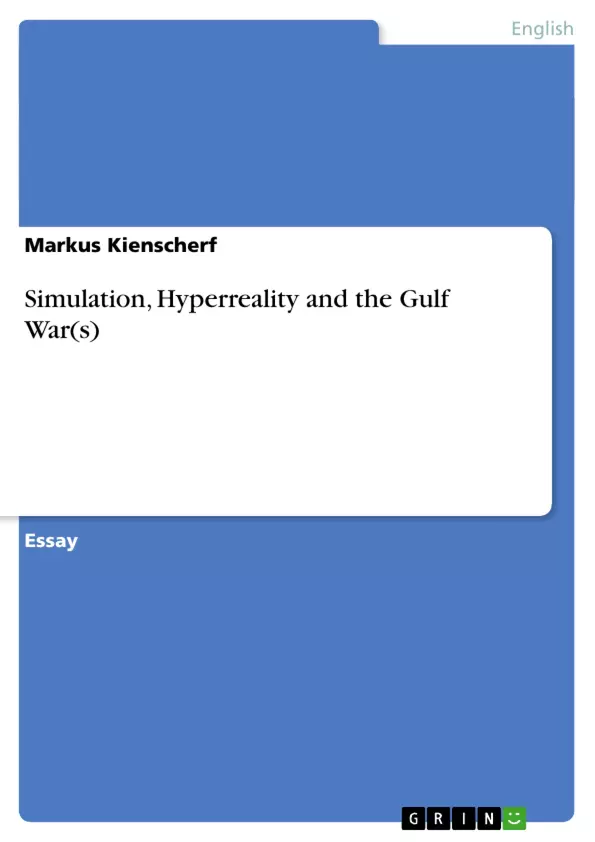“How do things stand with the real event, then, if reality is everywhere infiltrated by images, virtuality and fiction?”, asks Jean Baudrillard in his The Spirit of Terrorism (Baudrillard 2003:27-28) He already seems to know the answer to this, apparently, purely rhetorical question. Or does he? Baudrillard has become (in)famous for his controversial claim that we are living in an age of simulation and hyperreality, or what he calls the ‘third order of simulacra’ (Baudrillard 1993:50). The following paper will try to disentangle some of Baudrillard’s arguments clustering around ideas of the simulacrum, hyperreality and simulation. Arguing that the last two gulf wars constitute concrete examples of simulation and hyperreality, both in terms of the (hyper)real events on the ground and in terms of the images bombarding our living rooms, it will, then, explore these events in the light of Baudrillard’s ideas. In Simulacra and Simulation Baudrillard argues that in our current era of simulation the real is preceded by, and generated from, models, in a free play of signifiers which only refer to other signifiers (Baudrillard 1994:1-2). This constitutes the “third order of simulacra”, in contrast to the ‘second order’ which was still dominated by production and a market law of value (Baudrillard 1993:50). Baudrillard uses the term value in both its economic and linguistic sense. Drawing on Marx and Sausurre he differentiates between two dimensions of value. First, there is a structural aspect corresponding to Marx’s idea of exchange value. Each sign within a signifying system or each commodity within a system of exchange can be related to each other sign or commodity – “the structural dimension”. The second aspect is functional, relating each term to what it designates (signifier to signified; sign to referent) or each commodity to its potential use (Marx’s use-value) – “the referential dimension” (Baudrillard 1993 :6-9).
Inhaltsverzeichnis (Table of Contents)
- Introduction
- Simulation and the Hyperreal
- The Gulf War: shall we take it for (hyper)real?
- A Conclusion - Maybe Not?
Zielsetzung und Themenschwerpunkte (Objectives and Key Themes)
This paper aims to explore the concepts of simulation and hyperreality as theorized by Jean Baudrillard, using the Gulf Wars as concrete examples. It seeks to unravel the complex relationship between images, virtuality, and the real event in the context of these wars.
- The concept of simulation and hyperreality
- Baudrillard's theory of the simulacrum
- The role of images and media in constructing reality
- The Gulf Wars as examples of simulated reality
- The relationship between the 'real' and the 'virtual' in modern society
Zusammenfassung der Kapitel (Chapter Summaries)
- Introduction: The introduction sets the stage by introducing Baudrillard's question about the relationship between reality and images in an age of simulation and hyperreality. It outlines the paper's objective to examine these concepts through the lens of the Gulf Wars.
- Simulation and the Hyperreal: This chapter delves into Baudrillard's theory of the simulacrum and its implications for understanding our contemporary world. It discusses the shift from a "second order" of production and value to a "third order" of simulation, where signs refer only to other signs, severing the link between signifiers and signified.
- The Gulf War: shall we take it for (hyper)real?: This chapter explores how the Gulf Wars embody the concepts of simulation and hyperreality. It examines both the 'real events' on the ground and the media representations that bombarded viewers in their homes, highlighting the blurring of boundaries between reality and simulation.
Schlüsselwörter (Keywords)
This paper focuses on the concepts of simulation, hyperreality, and the simulacrum as theorized by Jean Baudrillard, applying these concepts to the Gulf Wars as examples. Key themes include the role of images and media in shaping our understanding of reality, the blurring of boundaries between the 'real' and the 'virtual', and the implications of living in an era of simulated experience.
- Citation du texte
- M.A. Markus Kienscherf (Auteur), 2004, Simulation, Hyperreality and the Gulf War(s), Munich, GRIN Verlag, https://www.grin.com/document/47023



